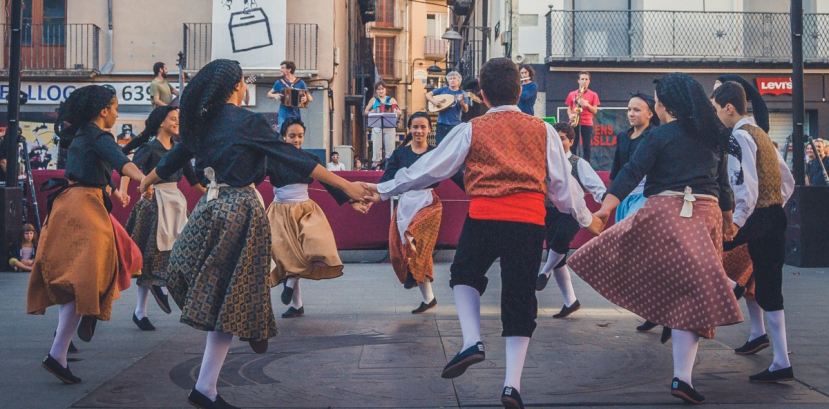Catalonia is an autonomous community in the northeastern corner of Spain. It consists of four provinces: Barcelona, Girona, Lleida and Tarragona. In the province of Girona lies Les Preses, a little village with a population of around 2,000. It was here that in 1981 the ensemble ESBART MARBOLENY was founded at the Cercle de Cultura Tradicional i Popular. The ensemble is one of the three sections at the Cercle, the other two being Grup de Recerca Folklòrica de la Garrtoxa (a research group) and Ésdansa (an international folk festival). Since its foundation ESBART MARBOLENY has been constantly evolving, restlessly looking for inspiration and drawing on traditional dances as basis on which to devise new creations, as well as performing choreographic routines the way ancestors danced them. The ensemble is divided into three age groups: Marboleny Escola (4-15 years of age) is where children have first contact with traditional music and dance (presently, it numbers 150 members); Marboleny Jove (16-18 years of age), where traditional dance becomes an element of artistic expression as well as individual and collective identity; and Marboleny Cos de Dansa (an adult group).
The Festival audience will have an opportunity to see a medley of dances presenting the richness of Catalan traditions: ball de les gitanes de Sant Celoni (a carnival masquerade dance originated in the 18th century, accompanied by castanets and bagpipes), ball de nans de la patum de Berga (a medieval dancing celebration and one of the most important folkloric testimonies to Catalan culture), ball pla d’Alinyà (a couple dance of gentle and graceful movements), ball pla de Canejan (a dance from the municipality of the Aran Valley), Hereu Riera (a dance with multiple meanings, e.g. performed at a tavern to decide who will pay for the drinks), bolengera (a joyful circle dance of French origin).
Roger Casalprim Casas is the ensemble leader, and Cristina Soler, Sergi Ventura and Joan Naspleda are the ensemble choreographers. The musicians will be playing bandurria (a plucked chordophone), llaüt (a lute), flauta (a flute), guitarra (a guitar), a violin, castanyola (castanets), pandereta (a small tambourine).
The Festival audience will have an opportunity to see a medley of dances presenting the richness of Catalan traditions: ball de les gitanes de Sant Celoni (a carnival masquerade dance originated in the 18th century, accompanied by castanets and bagpipes), ball de nans de la patum de Berga (a medieval dancing celebration and one of the most important folkloric testimonies to Catalan culture), ball pla d’Alinyà (a couple dance of gentle and graceful movements), ball pla de Canejan (a dance from the municipality of the Aran Valley), Hereu Riera (a dance with multiple meanings, e.g. performed at a tavern to decide who will pay for the drinks), bolengera (a joyful circle dance of French origin).
Roger Casalprim Casas is the ensemble leader, and Cristina Soler, Sergi Ventura and Joan Naspleda are the ensemble choreographers. The musicians will be playing bandurria (a plucked chordophone), llaüt (a lute), flauta (a flute), guitarra (a guitar), a violin, castanyola (castanets), pandereta (a small tambourine).

